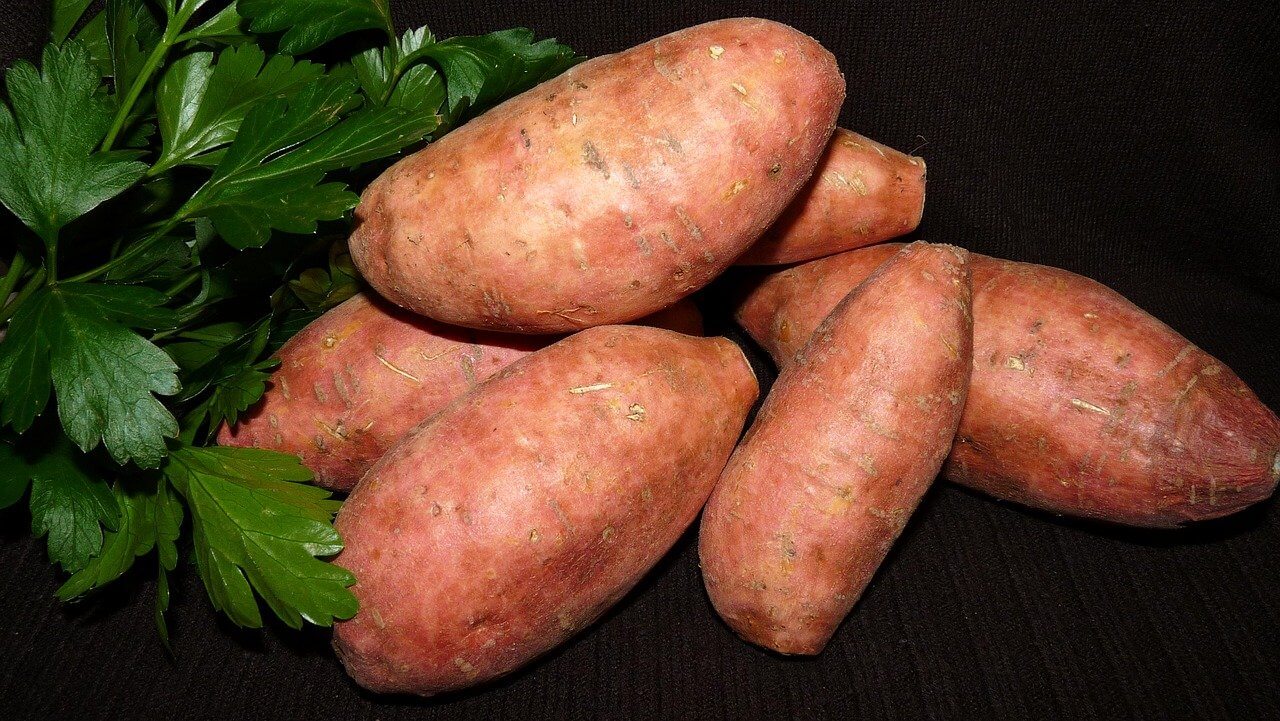Sweet potatoes (or yams) are one of those great storing vegetables. They will last for a good long while, as long as they are correctly stored – and we are here to tell you how to store sweet potatoes for the winter!
If you have a glut of sweet potatoes, or you have bought loads from the shops and need to know how to store them, read on…
What You'll Learn Today
How To Store Sweet Potatoes For Winter

Sweet potatoes are very like their standard potato cousins, in that you can store them for a long time and have them still be good when you go to cook them – if you use the correct storage ideas.
Storing sweet potatoes can actually improve their flavor – they are, of course, delicious right after harvesting, but leaving them for a while will allow their flavors to develop – as long as you store them correctly.
Curing sweet potatoes ready to store
Meat, fruit cakes and other foodstuffs benefit from a period of “curing” – that is, allowing their flavors to develop and mature – for a time before they are eaten. Curing sweet potatoes is simple:
- Place the tubers into a warm place with high humidity. Ideal temperatures are 79-84 degrees F (26-29 C), with a humidity of 80%.
- Indoor temperatures are generally around 59 to 73 degrees F (15 to 23 C), so you may want to leave your potatoes curing for as long as two weeks.
- Place them into a box, in a single layer, and cover the box with a cloth to enhance the humidity.
- Avoid damaging the tubers, and remove any that are damaged, as this will encourage mold and rot.
- After two weeks, remove your sweet potatoes and get them ready to be stored for winter.
Best way to store sweet potatoes for winter
- To store them correctly, wrap each one in newspaper or place them into cardboard boxes (plastic boxes will increase the chances of spoiling, as they can make the temperature too hot and the potatoes may sweat).
- Store them in cool temperatures. In a pantry that is colder than the rest of your house, or even outside in a shed – provided your shed doesn’t get too cold.
- Check the sweet potatoes often to check for any mildew or mold that may spread and ruin your harvest.
- Keep them in one single layer, so as to avoid them getting damaged or squashed, or passing on mold or mildew to each other.
Alternative Ways To Store Sweet Potatoes For Winter
In the days when living was harder, our grandparents may have stored sweet potatoes for the winter slightly differently. There are also alternative methods for if you do not have the space or resources to store your potatoes whole.
1. In site banking
This is a method that involves outside raised beds and soil. It is quite complex; a circular bed with high earth walls was constructed, then the base filled with straw.
The potatoes would be piled up into a cone structure, then boards would be placed around them in a tee-pee shape, and about 10 inches of straw packed on top. Soil would be then mounded over the straw, with boards around the bottom to prevent rain run off getting into the potatoes.
This method would keep the freezing weather and rain out, yet still allow the potatoes to be just warm enough, and well ventilated, in order to survive the winter.
2. Storing in sand
Sand will keep the sweet potatoes warm enough so that they don’t freeze, while at the same time providing ventilation and cushioning the roots from damage.
You can pack sand in layers in barrels or tubs, and place a layer of potatoes over each, and store them in a cellar that is not too cold (the sand will keep them relatively cool).
3. Fermenting
If you don’t have the options, or the space, to store your sweet potatoes whole, you can process them into a batch of lacto ferments. This is a relatively easy thing to do, which retains every bit of nutritional goodness from the potatoes as well as adding a little more goodness in the form of probiotics.
Here is a little video on the basics of fermenting sweet potatoes; there are many variations but this is a good start:
Where Not To Store Your Sweet Potatoes For Winter
- First and foremost, don’t store your sweet potatoes in the fridge. They don’t like extreme temperatures, and being too cold will make them rot and go bad.
- Make sure their storage space is not too hot. High heat will increase the chances that your sweet potatoes will mold and go bad.
- Don’t store them jumbled up with lots of other veg. Close proximity to another vegetable that is molding, or even ripening, will encourage mold and rot in your precious sweet potatoes.
- Keep them in a single layer, or wrapped individually. This will prevent any mold or diseases passing from one to the other.
Final Words
Storing sweet potatoes for the winter is easy, simple, and will reward you with perfect specimens of your favorite vegetable all through the hard months. It is so worth it, so have a look through these methods of how to store sweet potatoes for winter to make the most of your sweet potato harvest.
For how long should I store sweet potatoes without worrying about them going bad?
If stored correctly, you can leave your sweet potatoes for a month or even longer. Keep them in a cool, dark, dry place, in a loose weave bag or other container that allows air circulation, and check on them every now and then to make sure they are not going squishy or starting to sprout.